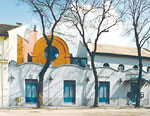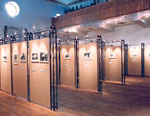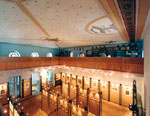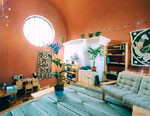USEFUL THINGS TO KNOW ABOUT THE HUNGARIAN MUSEUM OF PHOTOGRAPHY
When and how was it established?
There were three criteria to be met in order to establish the museum. 1. It was decided in the meeting room of the then FŐFOTÓ in 1991 that the representatives of photography present would found the Hungarian Photography Fund ensuring the financial and organisational background of the future Museum of Photography. The Budapest Photography Co-operative (today Budapest Photography Co. )contributed with HUF 2 million, the Association of Hungarian Photographers with HUF 25, 000, but later several photographic firms (Fuji Hungary Ltd, REANAL /today Reafotó, FORTE, FŐFOTÓ/ today Photo Hall, Nikon Ltd., OPTIFORT, and the Ministry of Cultural Affairs also joined the Fund. A great number of photographers and also civilians within and beyond the frontiers, who love photography, have given support. Lacking regular state or local government subsidies, the museum has been operating and developing for 13 years now from the income it generates, from moneys won from applications and from sponsors and also from private offers. 2. The Council of Bács-Kiskun County in co- operation with the Committee for the Protection of Historic Monuments and the Ministry had the ruinous building of the orthodox synagogue in the centre of the town converted into a museum and handed it over to be used as a museum free of charge. 3. This way it became possible that the 73.000 items of the Photo-historical Collection that had been collected since 1958 by the Association of Hungarian Photographers could be placed and developed adequately and function at a higher level as a real museum.
What does the museum collect?
Being the only special national museum collecting, preserving and exhibiting photographs exclusively, first of all it collects photographs. In its collection of over 1 million items, the first daguerreotype was photographed in 1840 and the latest picture is dated 18 June 2004, but at the time when you will be reading these lines, there will be some fresher ones. This makes it clear that the Museum of Photography does not forget that the photos of today will have historic value tomorrow, although historic and artistic priorities dominate when developing its collection. This is why it receives and buys from and exchanges photos with renowned contemporary authors as well. B ut the Hungarian Museum of Photography does not only collect pieces of photographic art to be handled as objects of art. Its photo-archive is really considerable offering several hundreds of thousands of photos in about 120 fields to the media, publishers and companies using photos and to researchers interested in special topics.
Does it store Hungarian photos or those with universal value?
Both, but the concept is different. In its Hungarian collection the museum aims at completeness, i. e. to collect pictures from each period, from each trend, from each significant author and it even stores properties bequeathed. As regards universal photography, due to its rather restricted financial resources, the museum can only occasionally purchase and exchange some outstanding photos. T he authors of the most significant bequeathed properties are: Márta Aczél, Angelo, Andor Angyalfy, Rudolf Balogh, Nándor Bárány, Pál Bence, Zoltán Berekméri, Ferenc Berendi, Sándor Bojár, Lajos Czeizing, Tibor Csörgeő, Károly Divald, Mihály Eke, Károly Escher, Jacques Faix, László Fejes, Károly Gink, Sándor Gönci (Frühof), F. G. Haller, Iván Hevesy, Gyula Holics, Rudolf Járai, Kata Kálmán, Ervin Kankovszky, Judit Kárász, István Kerny, Imre Kinszki, György Klösz, Károly Koffán, Miklós Korschelt, Klára Langer, Ferenc Lapu, József Lipthay, Manó Mai, Olga Máté, József Pécsi, Márta Redner, Marian Reismann, János Reismann, Pál Réti, Miklós Rév, Pál Rosti, Endre Rozsda, Zsuzsa Sándor, József Schermann, József Seidl, Jenő Sevcsik, József Sólyi, Kata Sugár, Géza Szakál, József Szászvárosi, Aladár Székely, Kálmán Szöllősy, János Sztály, András Tokaji, Ede Tomori, Ernő Vadas, Jolán Vadas, Ernő Vajda, László Vámos, István Vecsényi (Wetschka), Ferenc Veress, Iván Vydareny, Zoltán Zajky and Erzsébet Zinner.
What is the pride of the collection?
First, in those natives of Hungary who have achieved prominence abroad. We have considerable collections from André Kertész, László Moholy-Nagy, György Kepes, Robert and Cornell Capa, Paul Almásy, Brassai, Martin Munkácsi, Lucien Hervé, Ata Kando, Nicolas Muller, Ferenc Haár, Ferenc Berkó, Éva Besnyő, György Lőrinczy, Mari Mahr, Sylvia Plachy, Károly Szathmári Pap, Ferenc Aszmann, Irén Blüh, Béla Kálmán, Ervin Marton and several other. Not less respected are the works of photographers who stayed in Hungary, like József Pécsi, Rudolf Balogh, Károly Escher, Angelo, Olga Máté and besides them about half a thousand other authors. The pictures of the contemporaries: Tamás Féner, Péter Korniss, Gábor Kerekes, Demeter Balla, Imre Benkő, András Bánkuti, Sándor Sára, András Baranyay, István Gellér B., Lenke Szilágyi, György Tóth, Antal Jokesz, András Bozsó, Ernő Fejér, Kálmán Gábos, György Jankovszky and Zsuzsa Kemenesi, are kept in air-conditioned storerooms. The material of the last decade ’s press photography exhibitions is also stocked here. Our photographic database stores data on about forty thousand Hungarian photographers, snap-shooters and people related to this kind of art and trade, including biographic data and details of their oeuvres. A mong the pictures by the representatives of universal photography you can find photos by J osef Sudek, Frantisek Drtikol, Albert Renger-Patzsch, Henri Cartier-Bresson, Erna Lendvay- Dircksen, Roman Vischnac, Dmitrij Baltermanc, Yevgeny Khaldei. And this is not all. We can be proud of our developing, special collection that bears the name of “photo-Hungarica ” containing old and recent photos by foreign photographers who had once or recently worked in Hungary. Erich Lessing, Mario de Biasi, Ara Güler, Ferdinando Scianna, Chim, Jindrich Streit, Sarah Moon, Eva Rubinstein, Inge Morath, Henri Cartier-Bresson –has already been mentioned – and lots of others, sons of several nations send us the memories of their visits to Hungary.
What else do we collect?
Let me just mention some entries: original negatives, cameras and all kinds of equipment used to take and develop photos, paying special attention to those produced in Hungary or being important from the point of view of cultural or photographic history. We also collect the relics of famous photographers, exhibition medals, awards, archival documents, manuscripts on photography, books, small prints, postal and letter stamps with photos and different mediums of photographic advertisements, recollections recorded on sound, video, CD and other media, interviews, books, albums and other publications. Our collection of optical and other objects paving the way for photography is considerable and they represent the different steps of the development of vision in cultural history (laterna magicas, zoetrops, kinoras, shiluettes). Our special collection of technical history is also important. There we store the documents of the continuous changes of photography. We can illustrate more than 120 different processes with original works of art, starting from daguerreotypes and talbotypes to heliochroms, autochroms to woodburytypes. Our collection of postcards contains nearly a hundred thousand pieces. W hat I have always been saying half jokingly, half seriously, is that the museum collects first of all friends and patrons because they are less in number than the relics of photographic history.
What else does the Museum of Photography do?
It collects, preserves, restores, scientifically processes, exhibits and digitalises the items of the above mentioned collections. Besides this, it publishes books, enriching the Hungarian photographic literature with 4-5 monographs each year. With its accumulated knowledge it helps researchers, provides practical placement for students and gives support to other museums, collections and individuals. The museum itself carries out basic research and develops databases. It pioneers in having photos as such recognised as works of art and maintains daily contact with foreign partner institutions, photographers and researchers. Each year it organises 8-10 exhibitions within the museum and at other venues, plus 4-5 abroad. It has been working for three years to have its whole collection and all of its services available on the Internet.
Where is this museum?
It is in Kecskemét, 80 kilometres from Budapest. The building originally used to be an 18th century stage- coach posting house, then a Food and Dance Hall to Pista – an institution to boost general condition – and finally, an orthodox synagogue.
When is it open?
All the year round, except Mondays and Tuesdays from 10 a.m. to 17 p.m., during winter time it closes an hour earlier.
Where can you get further information?
In person, by ordinary and e-mail or fax, by phone and from our website on the Internet.
Those who wish to find us in person should remember the following address:
H–6000 Kecskemét, Katona József tér 12.
If you prefer writing a letter, would you please send it to:
H–6001 Kecskemét, Pf. 446.
Our fax number is: 36/76/508-259.
You do not like writing? We understand it.
Our phone numbers are: 36/76/483-221 or 36/76/508-258
Our e-mail address is: fotomuz@.c3.hu
And you can browse our website at: http://www.fotomuzeum.hu/
At present 20.000 of our photos and several databases of ours can be explored at http://www.fotoklikk.hu/








































































































































































